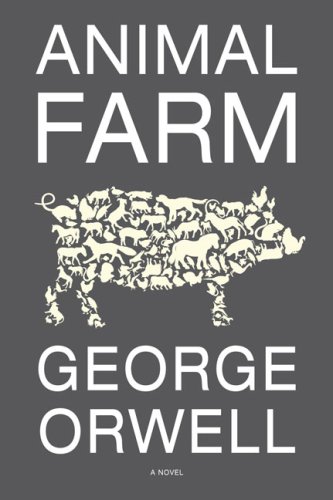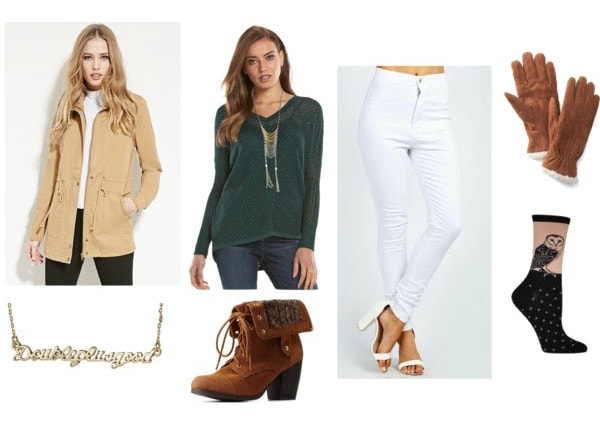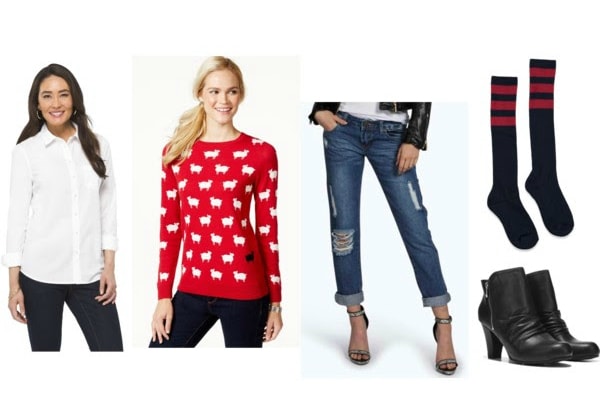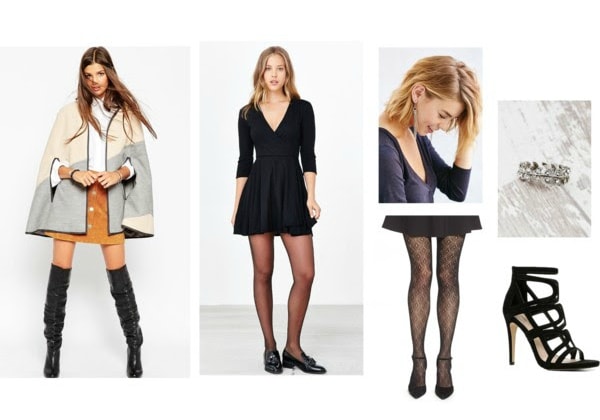Fashion inspiration can be found anywhere, and books are incredible sources for style innovation. Book-Inspired Fashion explores these treasure troves, and brings them them to you in looks inspired by vibrant characters, far away lands, brilliantly woven plot lines, and more.

I hope all of you have had an amazing holiday season, and that you are treasuring the brief reprieve before the semester starts up again! Because Animal Farm is such a widely read book in school, I thought it’d be an appropriate segue into 2016, as a book we can all discuss.
Table of Contents
Reading Between the Lines
Animal Farm, well-known as a satire that (poorly) disguises the biting political allegory represented by an unforgettable cast of animal characters, is among English author George Orwell’s two most famous works. (The other is 1984.) Clocking it at around 100 pages, this novella is relentlessly powerful and memorable despite – and perhaps due to – its brevity.
It was published in 1946 amidst political and social turmoil. Orwell intended the work to draw a critical eye to totalitarian governments, specifically the Soviet Union and the feud between Stalin and Trotsky. Given the subject matter, Orwell struggled to find a publisher willing to release the book, despite many acknowledgements of the work’s quality.
Animal Farm was eventually published after the end of the war, a few years after Orwell wrote the original manuscript. Despite its numerous early rejections, it is today considered one of the greatest works of the 20 century.
The extensive cast of characters includes the pigs Snowball, Napoleon, and Squealer, the hard-working horse pair Boxer and Clover, and the aloof, taciturn donkey Benjamin. They live among sheep, cows, hens, dogs, and more, and establish themselves as a true community after the death of the Old Major, who expounded the evil of man and need for liberty.
The tale begins with victory, after the group successfully runs Mr. Jones out of his farm. They are able to establish a set of commandments and announce the importance of equality, peace, and the natural state of animals – no clothing, alcohol, and especially no tolerance for any creature that walks upon two feet.
Unfortunately, the Animal Farm falls into disharmony and increasingly frightening turns of manipulation on the part of the intelligent pigs, who gradually establish themselves as the farm’s superior animals. They take advantage of the poor memory of the loyal group of animals, twisting truths and past events to suit their current purpose, and work the animals harder than ever before. Leader Napoleon even begins working with humans despite the commandments’ clear statement against them. Eventually, corrupt leadership brings about a full reversal of the society’s founding principles.
The three looks I’ve created are based on three quotes that stood out to me when I read the book for the first time – which embarrassingly enough, was recently. These aren’t necessarily the scenes that best represent the allegorical nature of the novella, but they are the ones that made me sit back and think the most.
Spoiler alert: The second and third outfit sets below contain spoilers, of varying degrees, so please skip over the descriptions if you don’t want the ending to be revealed to you in great detail!
1. Four legs good, two legs bad
After much thought Snowball declared that the Seven Commandments could in effect be reduced to a single maxim, namely: “Four legs good, two legs bad.” This, he said, contained the essential principle of Animalism. (25-26).

Products: Jacket, Sweater, Jeans, Socks, Boots, Gloves, Necklace
To compensate for the short-term memory of many of the “lower” farm animals, the first two commandments (1) Whatever goes upon two legs is an enemy, and (2) Whatever goes upon four legs, or has wings, is a friend, are combined into a shorter mantra: Four legs good, two legs bad! This remains in place for much of the book, and unifies the animals around one of the few traits they all share.
To reflect the variety of characters comprising Animal Farm, this look follows a consistently earthy, but not uniform color palette. Nothing really clashes because this phrase represents consistency: humans are the ultimate enemy, and everyone else is a friend. The brown gloves and boots are a subtle representation of the idea of four legs instead of just two, and hint at the idea of work rather than leisure.
The necklace references 1984, George Orwell’s other great work, that was just as controversial and well-written.
Also Read: Book-Inspired Fashion: The Alchemist
2. Life Would Go On
Benjamin was the only animal who did not side with either faction. He refused to believe either that the food would become more plentiful or that the windmill would save work. Windmill or no windmill, life would go on as it had always gone on – that is, badly. (38)

Product Info: Sweater, Blouse, Jeans, Socks, Boots
At first, life without human interference seems like paradise. However, things soon change due to secret amendments to the commandments and an unbalanced social order that severely favors the pigs. Benjamin neither participates nor demonizes the pigs, even though he knows exactly what is going on.
The first and only time Benjamin takes physical and verbal action to prevent anything is when his only true companion, loyal Boxer, is taken away by a horse slaughterer – arranged by the pigs who promised to send him to a surgeon. This is a shocking scene because Boxer both supported Napoleon and worked the hardest of any of the animals of the farm. It would seem that if any non-pig were to receive an ounce of sympathy, mercy, or special treatment, it would have been Boxer. Unfortunately, this does not come to pass, and charismatic Squealer convinces most of the animals that the vehicle had simply been mislabeled.
Benjamin is my favorite character, and this is because he is true to himself and consistent to the end. His steadiness and intelligence is refreshing, despite his pessimistic air. The fact that life goes on, no matter what happens, is a phrase attributed to him at least a few times in the novella. I find this interesting because it’s more subtle than the overlying political message of the book.
It’s this multiplicity of themes that I wanted to evoke with this outfit, which I did by incorporating layers, including the long socks underneath the looser jeans.
I chose this sweater in part because of the sheep print, as the sheep are a large part of the Animal Farm population, but also because of the bright red color. Red symbolizes a number of things: communism, blood and violence, passion, and more. All of these attributes are present, and the purposeful killing of the farm animals and Boxer is just one example of the bloodshed that wasn’t ever supposed to exist.
3. Deadly Silence
It was Clover’s voice. She neighed again, and all the animals broke into a gallop and rushed into the yard. Then they saw what Clover had seen.
It was a pig walking on his hind legs.
Yes, it was Squealer. A little awkwardly, as though not quite used to supporting his considerable bulk in that position, but with perfect balance, he was strolling across the yard. And a moment later, out from the door of the farmhouse came a long file of pigs, all walking on their hind legs.
[…] Out came Napoleon himself, majestically upright, casting haughty glances from side to side, and all with his dogs gambolling round him. He carried a whip in his trotter.
There was a deadly silence. (95)

Product Info: Poncho, Dress, Tights, Shoes, Earrings, Ring
This scene is by far the most shocking in the book, and delivers an emotional punch even if you saw it coming. It represents the reversal of the most important rule of Animal Farm, because the pigs have now become indistinguishable from the humans, who were formerly their sworn enemies. Not only do the pigs now walk, but they drink alcohol, wear Mrs. Jones’ old clothing, and conduct dinner meetings with men. This revelation silences the animals of the farm, because there is no longer anything to believe in – they are again controlled by the same type of leader they had at the start, before Mr. Jones was chased away.
Two new mantras circulate the farm to suit the new order: “Four legs good, two legs better!” and “All animals are equal, but some animals are more equal than others.”
This look expresses the idea of disguise, because the pigs have not only fooled most of the animals on the farm, but have moved on to actually dressing up as the creature they abhorred and demonized: man.
The oversized poncho allows room for something to be hidden, and the rest of the outfit is set in a sophisticated black, reflecting the pigs’ attempts to elevate themselves to creatures that live and dine indoors, drink alcohol, and socialize with business partners. The jewelry also serves to illustrate their attempts to adorn themselves physically.
The tall heels emphasize the image of pigs walking on their hind legs, despite the fact that their anatomy makes it uncomfortable, unnatural, and difficult.
In the Next Book-Inspired Fashion post…
CF writer Madison will be joining me in writing this column in the new year, which will be an exciting change! Our articles will alternate, and I can’t wait to see what 2016 has in store for us and for all of you readers. Happy reading, and please keep it up with the book recommendations!
Your Thoughts?
Has the world of Animal Farm changed the way you view political fiction? Let us know in the comments below!
